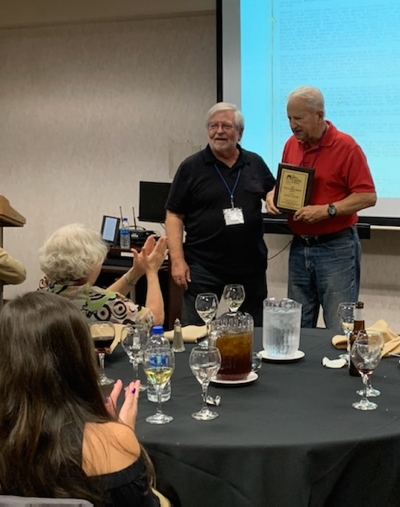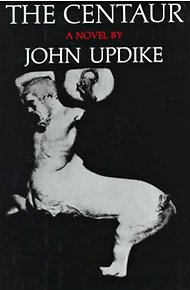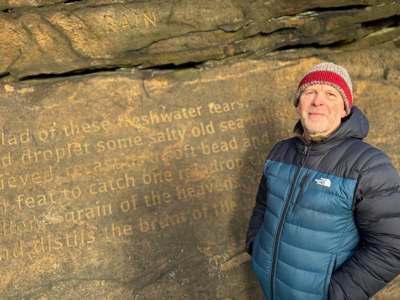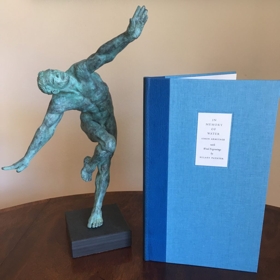 Leslie Pietrzyk, whose first collection of short stories, The Angel on My Chest, won the Drue Heinz Literature Prize, was selected over 193 applicants to be the 2025 John Updike Tucson Casitas Fellow. The fellowship consists of a $1000 prize from The John Updike Society and a two-week residency at the casitas formerly owned by John and Martha Updike, where the two-time Pulitzer Prize winner spent time golfing and writing in his later years. The casitas, located in the Santa Catalina Foothills, are owned by Jan and Jim Emery, and the annual residency is made possible by their generosity. (Photo: Wikipedia)
Leslie Pietrzyk, whose first collection of short stories, The Angel on My Chest, won the Drue Heinz Literature Prize, was selected over 193 applicants to be the 2025 John Updike Tucson Casitas Fellow. The fellowship consists of a $1000 prize from The John Updike Society and a two-week residency at the casitas formerly owned by John and Martha Updike, where the two-time Pulitzer Prize winner spent time golfing and writing in his later years. The casitas, located in the Santa Catalina Foothills, are owned by Jan and Jim Emery, and the annual residency is made possible by their generosity. (Photo: Wikipedia)
While at the casitas, Pietrzyk will work on Nothing to See Here, a collection of linked stories about a neighborhood girl who disappears from a Midwestern town, written not as a police procedural or Gone Girl mystery, but rather to address the “emotional impact of growing up in a time and place where girls and women disappear.” She talks briefly about her project in this interview.
Lead judge Robert M. Luscher, an Updike society board member, praised Pietrzyk for tackling a “variety of significant cultural issues in its metaphoric critique of female disappearance. Though these stories of peripheral, collateral damage are set in the 1970s, sadly their themes are even more relevant today than the time during which the stories take place.”

The porches at the casitas, where Updike liked to write while looking at a spectacular view of Tucson.
John Updike was the subject of Pietrzyk’s senior creative writing project at Northwestern University. She received her B.A. in English/Creative writing from Northwestern and an M.F.A. from American University. Currently teaching in the Converse University Low-Residency MFA program in Spartanburg, S.C., Pietrzyk has published three novels (Pears on a Willow Tree, A Year and a Day, and Silver Girl), one historical novel (Reversing the River), and two short story collections (This Angel on My Chest and Admit This to No One). Her story “Stay There” won a 2020 Pushcart Prize, and she was named co-winner of the Polish American Historical Association’s 2020 Creative Arts Prize for promoting “an awareness of the Polish experience in the Americas” through her fiction. Previously she completed residencies at Hawthornden Castle, the Virginia Center for Creative Arts, the Kimmel Harding Nelson Center, Wolff Cottage (in Fairhope, Ala.), The Hambidge Center, and an ARGS Residency in St. Petersburg, Va.
Three judges for the John Updike Tucson Casitas Fellowship competition considered the quality of project, quality of writing sample, potential benefit to Updike studies or generating awareness, publication potential, and previous publications or relevant biographical details. Pietrzyk is the second recipient. The first was Dr. Sue Norton, a Technological University Dublin lecturer whose project was a critical essay, “Somewhere Between Feminism and Misogyny: Classic Updike on the Modern Syllabus.”
The annual competition is open to all writers, with the residency offered two weeks in May. Applications for the 2026 competition are due Nov. 1, 2025. See the John Updike Society website for details.

 With heavy hearts we report that the senior docent of The John Updike Childhood Home, David W. Ruoff, died Jan. 1 at age 83 of congestive heart failure while in hospice care in Ephrata. Dave became a member of The John Updike Society in 2012 after he began renting the single-story annex to The John Updike Childhood Home, back when it was still a deconstruction zone.
With heavy hearts we report that the senior docent of The John Updike Childhood Home, David W. Ruoff, died Jan. 1 at age 83 of congestive heart failure while in hospice care in Ephrata. Dave became a member of The John Updike Society in 2012 after he began renting the single-story annex to The John Updike Childhood Home, back when it was still a deconstruction zone. The society loved him back. On October 2, 2021, the board honored him as the sixth recipient of The John Updike Society Distinguished Service Award, praising his “extraordinary docent work and other services to The John Updike Childhood Home.” Dave was funny, generous, thoughtful, and a little bit larger than life. He’ll be greatly missed.
The society loved him back. On October 2, 2021, the board honored him as the sixth recipient of The John Updike Society Distinguished Service Award, praising his “extraordinary docent work and other services to The John Updike Childhood Home.” Dave was funny, generous, thoughtful, and a little bit larger than life. He’ll be greatly missed. course, played an important role for a lot writers—no need to list them all here.) John Ashbery enjoyed a nice cup of tea and classical music when he wrote, which was usually in the late afternoon. Charles Simic enjoyed writing when his wife was cooking. Eudora Welty could write anywhere—even in the car— and at any time, except at night when she was socializing. Flannery O’Connor could only write two hours a day and her drink was Coca Cola mixed with coffee. Simone de Beauvoir wrote from 10AM-1PM and from 5-9PM. Louise Glück found writing on a schedule “an annihilating experience.” A. R. Ammons wrote only when inspiration hit—he compared trying to write to trying to force yourself to go the bathroom when you have no urge. Anne Sexton took up writing after therapy sessions. Jack Kerouac had various rituals at different times—one was writing by candlelight, and another was doing “touch downs” which involved standing on his head and touching his toes to the ground. Ernest Hemingway and Virginia Woolf wrote standing up. Wallace Stevens composed poems while walking to work. Gabriel García Márquez listened to the news before writing. Amy Gerstler sometimes listens to recordings of rain while writing. I tried that once, and the rain put me into a deep and dreamless sleep.”
course, played an important role for a lot writers—no need to list them all here.) John Ashbery enjoyed a nice cup of tea and classical music when he wrote, which was usually in the late afternoon. Charles Simic enjoyed writing when his wife was cooking. Eudora Welty could write anywhere—even in the car— and at any time, except at night when she was socializing. Flannery O’Connor could only write two hours a day and her drink was Coca Cola mixed with coffee. Simone de Beauvoir wrote from 10AM-1PM and from 5-9PM. Louise Glück found writing on a schedule “an annihilating experience.” A. R. Ammons wrote only when inspiration hit—he compared trying to write to trying to force yourself to go the bathroom when you have no urge. Anne Sexton took up writing after therapy sessions. Jack Kerouac had various rituals at different times—one was writing by candlelight, and another was doing “touch downs” which involved standing on his head and touching his toes to the ground. Ernest Hemingway and Virginia Woolf wrote standing up. Wallace Stevens composed poems while walking to work. Gabriel García Márquez listened to the news before writing. Amy Gerstler sometimes listens to recordings of rain while writing. I tried that once, and the rain put me into a deep and dreamless sleep.”
 Greatest Books of All Time on Teachers,” and it’s no surprise that John Updike’s 1963 novel, The Centaur, ranks high on the list. His tribute to his father (and teacher), Wesley Updike, did win the National Book Award, after all.
Greatest Books of All Time on Teachers,” and it’s no surprise that John Updike’s 1963 novel, The Centaur, ranks high on the list. His tribute to his father (and teacher), Wesley Updike, did win the National Book Award, after all.


 With heavy hearts we report the death of longtime John Updike Society member Andrew J. Moorhouse, whom many members first met when he attended the society’s second biennial conference in Boston in 2012.
With heavy hearts we report the death of longtime John Updike Society member Andrew J. Moorhouse, whom many members first met when he attended the society’s second biennial conference in Boston in 2012. Inspired by Updike and Updike small-press limited edition publisher William Ewert, Andrew contacted UK Poet Laureate Simon Armitage, whose work he collected, asking if he’d be interested in working with him to produce fine press editions of his works. Armitage was interested, and in October 2013, Andrew started
Inspired by Updike and Updike small-press limited edition publisher William Ewert, Andrew contacted UK Poet Laureate Simon Armitage, whose work he collected, asking if he’d be interested in working with him to produce fine press editions of his works. Armitage was interested, and in October 2013, Andrew started